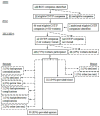Carbon nanotube and nanofiber exposure and sputum and blood biomarkers of early effect among U.S. workers
- PMID: 29698898
- PMCID: PMC5970999
- DOI: 10.1016/j.envint.2018.04.004
Carbon nanotube and nanofiber exposure and sputum and blood biomarkers of early effect among U.S. workers
Abstract
Background: Carbon nanotubes and nanofibers (CNT/F) are increasingly used for diverse applications. Although animal studies suggest CNT/F exposure may cause deleterious health effects, human epidemiological studies have typically been small, confined to single workplaces, and limited in exposure assessment.
Objectives: We conducted an industrywide cross-sectional epidemiological study of 108 workers from 12 U.S. sites to evaluate associations between occupational CNT/F exposure and sputum and blood biomarkers of early effect.
Methods: We assessed CNT/F exposure via personal breathing zone, filter-based air sampling to measure background-corrected elemental carbon (EC) (a CNT/F marker) mass and microscopy-based CNT/F structure count concentrations. We measured 36 sputum and 37 blood biomarkers. We used factor analyses with varimax rotation to derive factors among sputum and blood biomarkers separately. We used linear, Tobit, and unconditional logistic regression models to adjust for potential confounders and evaluate associations between CNT/F exposure and individual biomarkers and derived factors.
Results: We derived three sputum and nine blood biomarker factors that explained 78% and 67%, respectively, of the variation. After adjusting for potential confounders, inhalable EC and total inhalable CNT/F structures were associated with the most sputum and blood biomarkers, respectively. Biomarkers associated with at least three CNT/F metrics were 72 kDa type IV collagenase/matrix metalloproteinase-2 (MMP-2), interleukin-18, glutathione peroxidase (GPx), myeloperoxidase, and superoxide dismutase (SOD) in sputum and MMP-2, matrix metalloproteinase-9, metalloproteinase inhibitor 1/tissue inhibitor of metalloproteinases 1, 8-hydroxy-2'-deoxyguanosine, GPx, SOD, endothelin-1, fibrinogen, intercellular adhesion molecule 1, vascular cell adhesion protein 1, and von Willebrand factor in blood, although directions of associations were not always as expected.
Conclusions: Inhalable rather than respirable CNT/F was more consistently associated with fibrosis, inflammation, oxidative stress, and cardiovascular biomarkers.
Keywords: Biomarker; Blood; Carbon nanofiber; Carbon nanotube; Occupational; Sputum.
Published by Elsevier Ltd.
Conflict of interest statement
The authors declare they have no competing financial interests.
Figures

References
-
- Akaike H. A new look at the statistical model identification. IEEE Trans Automat Contr. 1974;19:716–723.
-
- Akpinar-Elci M, Stemple KJ, Enright PL, Fahy JV, Bledsoe TA, Kreiss K, et al. Induced sputum evaluation in microwave popcorn production workers. Chest. 2005;128:991–997. - PubMed
-
- Birch ME. Chapter DL: Monitoring diesel exhaust in the workplace. In: Ashley K, O’Connor PF, editors. NIOSH Manual of Analytical Methods. 5. U.S Department of Health and Human Services, Centers for Disease Control and Prevention, National Institute for Occupational Safety and Health; Cincinnati, OH: 2016. [accessed June 26, 2017]. DHHS (NIOSH) publication no 2014-151 Available at: http://www.cdc.gov/niosh/nmam/
Publication types
MeSH terms
Substances
LinkOut - more resources
Full Text Sources
Other Literature Sources
Medical
Research Materials
Miscellaneous

